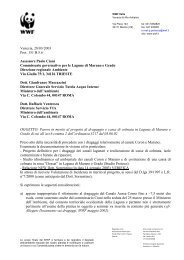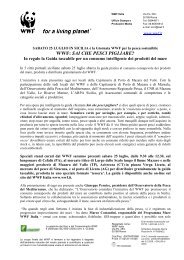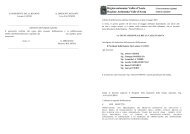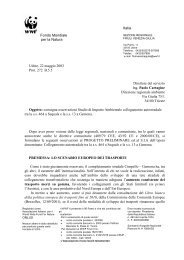il monumento naturale palude di torre flavia, un ... - WWF Italia
il monumento naturale palude di torre flavia, un ... - WWF Italia
il monumento naturale palude di torre flavia, un ... - WWF Italia
Create successful ePaper yourself
Turn your PDF publications into a flip-book with our unique Google optimized e-Paper software.
saggio, <strong>un</strong>ica residua evidenza <strong>di</strong> <strong>un</strong>a<br />
morfologia litorale ormai completamente<br />
alterata dall’antropizzazione<br />
della seconda metà del secolo passato.<br />
L’area umida protetta Monumento<br />
<strong>naturale</strong> “Palude <strong>di</strong> Torre Flavia” è<br />
situata l<strong>un</strong>go <strong>il</strong> litorale tirrenico a nord<br />
<strong>di</strong> Roma nei com<strong>un</strong>i <strong>di</strong> La<strong>di</strong>spoli e Cerveteri<br />
(Roma; coor<strong>di</strong>nale geografiche:<br />
41° 58’ N; 12° 03’ E). L’area estesa ca.<br />
40 ha, si sv<strong>il</strong>uppa parallelamente alla<br />
linea <strong>di</strong> costa in <strong>di</strong>rezione Nord-Ovest/Sud-Est per <strong>un</strong>a l<strong>un</strong>ghezza <strong>di</strong> ca. 1500 m,<br />
<strong>un</strong>a profon<strong>di</strong>tà massima verso l’entroterra <strong>di</strong> ca. 500 m e <strong>un</strong>a altitu<strong>di</strong>ne compresa<br />
tra 0 e 3 m ca. s.l.m. (Rif. Tav. IGMI 1:25000: 149 IV NO-Stazione <strong>di</strong> Furbara;<br />
CTR Regione Lazio 1:10000: 373010 “La<strong>di</strong>spoli nord”).<br />
L’area confina a Nord con inse<strong>di</strong>amenti abitativi del Com<strong>un</strong>e <strong>di</strong> Cerveteri<br />
(case basse massimo <strong>di</strong> due piani con <strong>il</strong> tipico aspetto chiaro delle case <strong>di</strong> mare in<br />
questa zona), a Sud confina con <strong>un</strong> campeggio esteso l<strong>un</strong>go la costa nel Com<strong>un</strong>e<br />
<strong>di</strong> La<strong>di</strong>spoli, ad Ovest con <strong>il</strong> mar Tirreno e ad Est con <strong>un</strong>a strada asfaltata che<br />
collega internamente (senza dover passare per la S.S. <strong>di</strong> Via Aurelia) La<strong>di</strong>spoli da<br />
Campo <strong>di</strong> Mare e Cerenova. L’area del Monumento <strong>naturale</strong> “Palude <strong>di</strong> Torre Flavia”<br />
racchiude in se <strong>di</strong>verse tipologie <strong>di</strong> ambienti che si completano tra <strong>di</strong> loro formando<br />
<strong>un</strong> piacevole paesaggio <strong>naturale</strong> che riesce a creare nel visitatore la sensazione<br />
<strong>di</strong> trovarsi molto lontani dal caos citta<strong>di</strong>no. Coesistono la <strong>palude</strong> e le zone<br />
d<strong>un</strong>ali, i campi più o meno incolti con i canali d’irrigazione.<br />
Si possono trovare ancora elementi della macchia me<strong>di</strong>terranea esistente<br />
prima della bonifica ed <strong>il</strong> livello variab<strong>il</strong>e dell’acqua presente negli acquitrini permette<br />
<strong>di</strong> avere <strong>un</strong> paesaggio sempre <strong>di</strong>verso durante i vari mesi dell’anno.<br />
Il livello delle acque viene attivamente regolato dalla Provincia <strong>di</strong> Roma che<br />
annualmente acquista 100.000 m 3 <strong>di</strong> acqua dal Consorzio <strong>di</strong> Bonifica al solo scopo<br />
<strong>di</strong> impe<strong>di</strong>re lo stress idrico ai fini conservazionistici. Questi investimenti permettono<br />
<strong>di</strong> svolgere l’attività della piscicoltura anche nei mesi in cui naturalmente<br />
non si creerebbero le pozze <strong>di</strong> acqua in<strong>di</strong>spensab<strong>il</strong>i per tale attività. La <strong>palude</strong><br />
è quin<strong>di</strong> stata conservata e questo ha portato anche <strong>un</strong> vantaggio sulle attività<br />
umane più o meno impattanti che in essa vengono svolte.<br />
Principali fattori <strong>di</strong> rischio<br />
<strong>di</strong> Francesco Maria Mantero<br />
Nonostante <strong>il</strong> <strong>monumento</strong> sia oggi salvaguardato da <strong>un</strong>a normativa locale<br />
e regionale e che la sua esistenza stia <strong>di</strong>ventando parte del patrimonio culturale<br />
della società, <strong>di</strong>versi sono i processi che possono mettere a rischio <strong>di</strong>rettamente<br />
ed in<strong>di</strong>rettamente la sua esistenza. Di seguito se ne <strong>il</strong>lustrano alc<strong>un</strong>i sinteticamente.<br />
Se l’e<strong>di</strong>ficazione, con le attuali norme, non può interessare <strong>di</strong>rettamente l’area,<br />
essa sicuramente può interessare l’imme<strong>di</strong>ato intorno del Monumento <strong>naturale</strong>.<br />
La domanda <strong>di</strong> seconde case e <strong>di</strong> strutture ed infrastrutture per l’uso delle aree<br />
costiere è molto forte, in particolare in aree come questa, posta vicino ad <strong>un</strong> va-<br />
CTR Regione<br />
Lazio<br />
1:10000:<br />
373010<br />
“La<strong>di</strong>spoli<br />
nord”<br />
17








